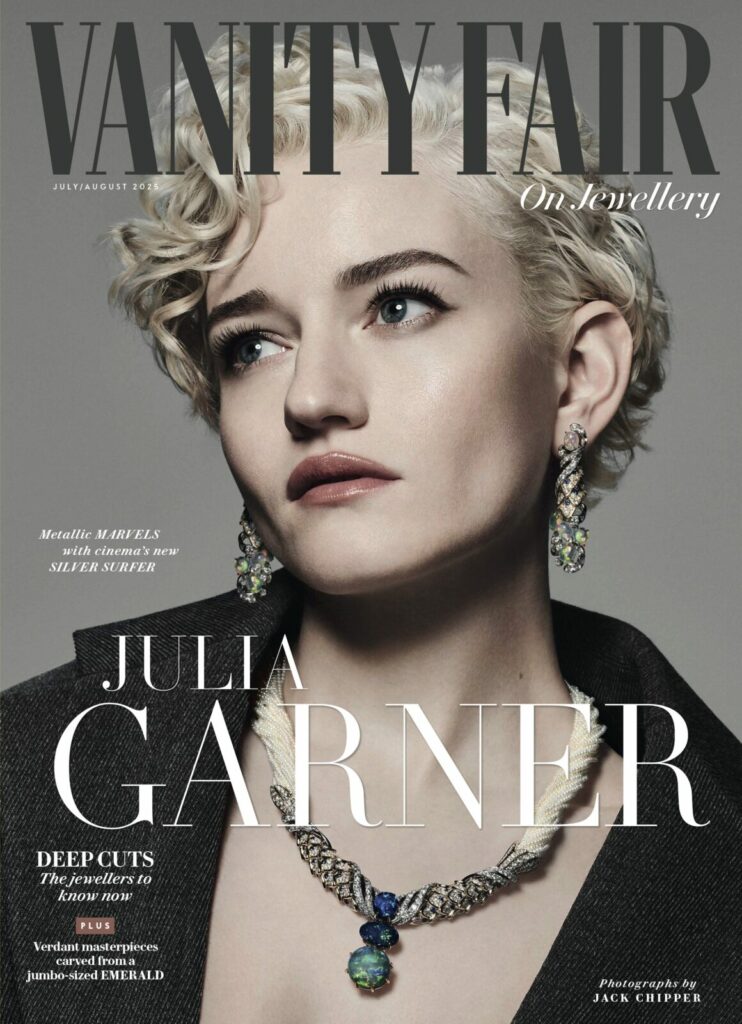
In the remote New Zealand countryside, Alice Herald has discovered independent miners who source gold without using cyanide or mercury-all the better to make her punky yet refined jewellery with, says Annabel Davidson
DIGGING DEEPER by Annabel Davidson
VANITY FAIR On Jewellery - July/August 2025
"THINK OF NEW ZEALAND, and most likely you'll envisage sheep, bungee jumping, the All Blacks, and Hobbiton, the movie set where some of the Lord of the Rings series was filmed. Very few people think of gold, but for jeweller Alice Herald, Aotearoa, the Māori word for New Zealand, and gold go hand in hand.
"Traceability and responsible luxury are hugely important to me," the Wanaka-based, British-born jeweller says. "And being in a small country like New Zealand, when you're very far away from the industry, you have the luxury of being more in control, as you're not that far from the source."
Herald's work, which ranges from ultra-wearable gold hoops striped with diamond rows, to dramatic, punkish bangles studded with diamonds and set with an oversized pink cabochon tourmaline, is now all made in traceable New Zealand gold-which wasn't possible until she pushed for it. "We have gold in New Zealand, and I've been badgering a foundry here for two years to keep it separate from other sources, such as recycled gold or scrap metal," she says. "Surely we must be able to make gold that is mined right here traceable? But it's down to volume.
It's not worth a foundry's time and effort to keep newly mined New Zealand gold separate from everything else."
That everything else is mainly lemel, the dust and tiny bits of gold from a jeweller's bench; scrap, old, broken or unwanted jewellery, watches, silverware or anything containing precious metal; and sweep, the dust and other accrued material from any space that uses precious metal. It's also newly mined gold from small-scale mines across Australia and New Zealand.
New Zealand has only a couple of large-scale mines, but on the West Coast of the South Island, private, small-scale contractors can mine for alluvial gold (which has been naturally eroded from mountains by melting glaciers), often using nothing more than gravity and magnets to separate the gold from the black sand and silt it is found in.
"A representative for the foundry that is now supplying me with pure New Zealand gold literally goes around these private miners and collects their gold in glass jam jars," Herald laughs. "And then it goes to the refinery in Auckland where it's kept completely segregated, locked in its own vault, and only cast on certain days when they don't cast any other type of gold."
Last year, in a bid to sate her curiosity and see for herself first-hand how the gold is mined, Herald travelled to meet one contractor, who mines a claim on a bit of farmland near the West Coast town of Hokitika as a side gig to his contracting business. Earlier this year, she returned to learn more. "He has been mining since he was 15, and he'd be in his early Gos now," Herald says.
"He drove me out to his claim past lots of exhausted ones, some of which haven't been touched since the 186Os." (New Zealand experienced a gold rush for about 20 years from the 186os.)
"There were old sites that were just holes, and mounds of debris and rocks, and he could tell me what era they were from because of their condition."
When they reached one particular stretch of farmland, consisting of beautiful green grass mounds, like small hills, the miner announced that he had mined that site, and as per Department of Conservation regulations, returned it to beautiful grazing land. "A year earlier, it had been this big water pit being mined, and now it's back to being lush green pasture," Herald says.
"What makes the way he mines so environmentally friendly is that he's working with the water table, so there's no transporting of water or dirty water run-off. They work within the pit, take the silt back to his big shed where they just separate the gold from the black sand by spinning it centrifugally and using water and gravity. There's no cyanide or mercury. It's just so incredibly simple." Simple, maybe, but if it wasn't for Herald spending years campaigning for her miner contact's gold-and others like it-to be segregated from the rest, New Zealand gold as a precious, traceable, responsibly mined product wouldn't exist. It's proof that the actions of one person can make a huge difference. May the industry as a whole follow suit."
